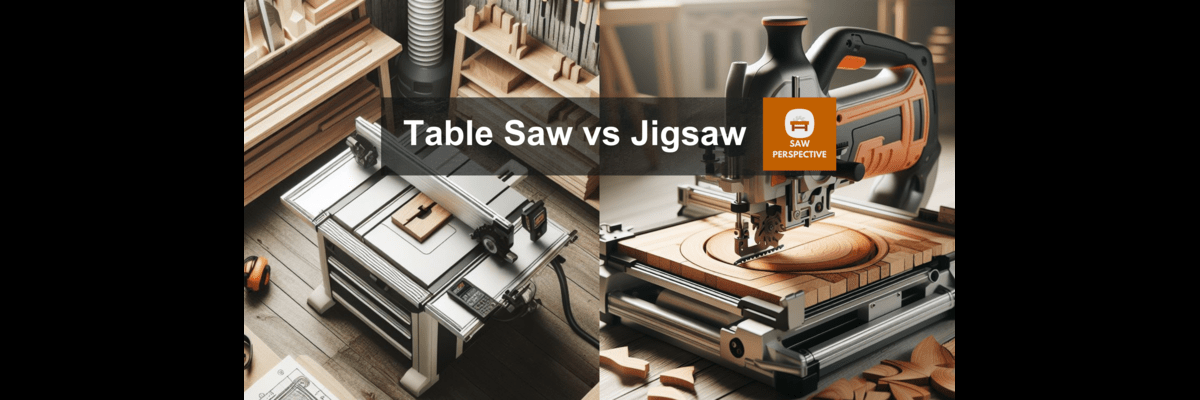Table saw are the masters of straight cuts. Their large, circular blades can rip through thick lumber with precision and power.
They’re also equipped with fences and miter gauges to help you make accurate cuts at any angle.
On the other hand, Jigsaws are the champions of curved cuts. Their small, reciprocating blades can navigate tight corners and intricate shapes with ease.
They’re also great for cutting through thinner materials like plywood or sheet metal.
| Parameters | Table Saw | Jigsaw |
| Functionality | Straight cuts, rip cuts, crosscuts | Curved cuts, intricate shapes, detailing |
| Cutting Mechanism | Circular blade above table | Reciprocating blade, handheld |
| Versatility | Various cuts, may struggle with intricacies | Highly versatile, ideal for detailing |
| Material Size | Larger materials, straight-cutting | Thinner materials, excels at curves |
| Portability | Varies, some models portable | Highly portable, handheld |
| Safety | Higher risk of kickback | Lower risk of kickback, generally safer |
| Speed | Generally faster | Slower but agile for intricate cuts |
| Application | Larger projects, straight cuts | Artistic projects, detailed woodworking |
| Cost | Artistic projects, detailed woodworking | Generally more affordable |
What Is A Table Saw?
A table saw is a woodworking tool with a flat surface and a circular blade that protrudes through the table, used for making precise cuts in wood.
What Are Table Saw Used For?
Table saws are used for various woodworking applications, including rip cuts, crosscuts, miter cuts, bevel cuts, and dado cuts, making them versatile tools for shaping and sizing wood pieces in construction and carpentry projects.
What Are Pros And Cons Of A Table Saw?
Pros
- Delivers precise cuts
- versatile for various tasks
- operates at high speed for efficiency.
Cons
- Substantial build for stability
What Is A Jigsaw?
A jigsaw is a handheld power tool with a reciprocating blade, designed for making curved and intricate cuts in various materials, including wood, metal, and plastic.
What Are Jigsaw Used For?
Jigsaws are used for applications such as cutting curves, circles, and intricate shapes in wood, metal, plastic, and other materials.
They are versatile tools suitable for various DIY projects, crafts, and detailed woodworking tasks.
What Are Pros And Cons Of A Jigsaw?
Pros
- Highly versatile for a range of cuts
- excels in curved cuts
- offers excellent portability
Cons
- operates at a manageable pace compared to Table Saw
- excels in precision for thinner material cuts
What Are Differences Between Table Saw And Jigsaw?
- Functionality:
Table Saw is designed for straight cuts whereas Jigsaw is tailored for making curved and intricate cuts.
- Cutting Mechanism:
Table Saw uses a circular blade protruding above the table for cutting whereas Jigsaw has a reciprocating blade that moves up and down for cutting.
Precision:
Table Saw offers high precision whereas jigsaw provides less precision.
- Versatility:
Table Saw is versatile for various cuts whereas Jigsaw is highly versatile, ideal for detailed and artistic woodworking.
- Material Size:
- Table Saw is suitable for larger materials whereas Jigsaw is better suited for thinner materials.
- Portability:
Table Saw models vary in portability whereas Jigsaws are inherently portable .
- Safety:
Table Saw poses a higher risk of kickback whereas Jigsaw generally has a lower risk of kickback.
- Speed:
Table Saw is generally faster whereas Jigsaw is slower .
- Application:
Table Saw is ideal for larger woodworking projects whereas Jigsaw is preferred for artistic projects.
- Cost:
Table Saw prices vary whereas Jigsaw prices are generally more affordable.
Table Saw Compared With Other Saws
Table Saw vs Miter Saw
Table Saw vs Circular Saw
Table Saw vs Track Saw
Table Saw vs Band Saw
Table Saw vs Hand Saw

